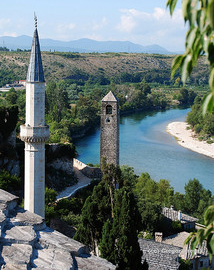Heritage Alert
 The Heritage Alert process uses ICOMOS’ professional and public networks to promote the conservation of cultural heritage and draw attention to the threats which it confronts and to promote good conservation solutions.
The Heritage Alert process uses ICOMOS’ professional and public networks to promote the conservation of cultural heritage and draw attention to the threats which it confronts and to promote good conservation solutions.
ICOMOS recognizes that publicizing and defining such matters requires a high degree of responsibility. The assessment of situations leading to a Heritage Alert being issued by ICOMOS will therefore be pursued with ethical rigor and accuracy. ICOMOS is by its nature multi-disciplinary, with expert members worldwide.
The Heritage Alert objectives
- Use the expertise of the members of the ICOMOS Scientific Committees and relevant ICOMOS National Committees to assess the significance of and threats to a property indicated to be at risk;
- Confirm the facts of the threat and the heritage significance of the property;
- Alert the public to the significance and threat to the property at risk using ICOMOS networks to publicize the situation;
- Selectively act to support the conservation of the property at risk;
- Maintain a list of properties at risk and follow the results of any conservation action for future analysis
- Provide input to the ICOMOS Heritage at Risk Report.
You wish to alert us?
To ensure the reputation and international credibility of the ICOMOS Heritage Alert response, a formal process has been established that will confirm that the heritage significance and threat is well understood before an ICOMOS Heritage Alert is issued.
Download the Heritage Alert template and send it once completed to the ICOMOS International Secretariat (secretariat[at]icomos.org)
Role of the ICOMOS National and International Scientific Committees
To handle requests for Heritage Alert actions, all ICOMOS National and Scientific Committees are encouraged to establish a small advocacy sub-Committee (annual rotation, renewable membership). These can for example consists of two Committee members, the Committee Secretary General and President (or nominee).
Heritage Alert Process
A five step process includes broad but fast consultation by the Advocacy sub-committee.
- Preliminary Assessment: When a proposal for an alert is received by the ICOMOS International Secretariat it is forwarded to the concerned National Committee and relevant International Scientific Committee(s). The Heritage Alert sub-committees of the National Committee or International Scientific Committee(s) provide initial confirmation that the case is of international or national significance. If so, the Advocacy sub-committee chair (or acting chair), forwards the Heritage Alert template to the proposer, and immediately invites comment and advice from the relevant National Committee of ICOMOS, if the request has been received by a Scientific committee or from the relevant ICOMOS Scientific Committee(s) if the request has been received by a National Committee. The ICOMOS Secretary General is advised of the issuing of a Heritage Alert template. Affiliated organizations may also be advised and invited to investigate or take action, such as joint support letters.
- Advocacy Sub-committee recommendation: The sub-committee Chair will receive the final template and associated documentation from the proposer. Additional or comparative material may be requested. The sub-committee will aim to assess and recommend on the Alert request by email within five business days whenever possible and recommend action to the National and/or Scientific Committee President whose decisions are final. The ICOMOS Secretary General and the relevant ICOMOS National Committee will be consulted regarding the proposed actions.
- ICOMOS National or Scientific Committee Action: The Committee Secretary General will prepare the necessary public documentation letters and media briefing material in consultation with the ICOMOS National Committee and the International Scientific Committee President, when applicable.
- ICOMOS Action: The ICOMOS Secretariat in Paris will facilitate the Heritage Alert being electronically forwarded to all ICOMOS members. The relevant National Committee and or ISC(s) will prepare any letters required, including the addresses, and they will be disseminated on ICOMOS letterhead by the ICOMOS Secretary General.
- Website Action: The Heritage Alert template and associated documentation will be uploaded on the relevant National or International Committee web site by their Secretary General.
Assessing proposals for Heritage Alerts
- Assessment criteria: The Advocacy sub-committees will respect established national and international guidelines for the significance assessment of heritage through analysis of history, fabric, form, function, use and design intent. ICOMOS recognizes that it is important to conserve not just building fabric, form and function, but the ideas and philosophies behind a building, structure or landscape and its use. ICOMOS may need to request and assess additional materials that rely on original research. Other critical information needed may include comparative knowledge of other similar or associated places.
- Scale of involvement: ICOMOS, as an international organization will generally respond only to requests of international/national urgency and forward other requests to national and local heritage organizations for action.
Decisions as to when a Heritage Alert will be accompanied by official correspondence from ICOMOS to relevant national authorities, or indeed an ICOMOS conservation campaign will be resolved between the National and/or International Scientific Committee President and the ICOMOS Secretary General. - Template: The Heritage Alert assessment template will be regularly updated, kept simple and the response methodology streamlined to ensure active and timely participation from the ICOMOS Advocacy sub-Committees, since members are working on a volunteer basis and have a limited capacity to respond to requests.
- Organizational relations: Ongoing relationships with cooperating international organizations running similar “heritage at risk” programmes are always carefully considered to ensure that the ICOMOS Heritage Alerts are both timely and effective.
